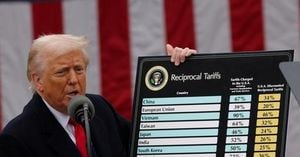Argentina is once again in the global spotlight, but not for the reasons its leaders might have hoped. The country’s economic turmoil has reached fever pitch, with the peso tumbling, inflation remaining stubbornly high, and government bonds yielding rates that would make even the boldest investors sweat. President Javier Milei, who swept into office on promises to “break the system” and usher in a new era of stability, now finds himself grappling with old problems wearing new disguises. The question on everyone’s mind: can Argentina really reinvent itself, or is it destined to repeat its economic tragedies?
Just this week, the peso slipped more than 10% against the dollar, breaching the so-called “corridor” the government had vowed to defend. The central bank has been burning through reserves at a breakneck pace, dumping over $1.8 billion into the market in a desperate attempt to prop up the currency. According to Bloomberg, this included $53 million sold on Wednesday and another $379 million on Thursday, all in the week of September 15–19, 2025. The peso hit a new low of 1,475 per dollar, breaking through the top end of its IMF-imposed trading band and sending shockwaves through the markets.
In response, authorities scrambled to impose new controls. The central bank banned shareholders and executives of banks from trading financial dollars—known locally as MEP and CCL—for 90 days after any official currency purchase. Reserve requirements were raised, and the government began offloading dollars from the Treasury and entering the futures market. But none of these moves have managed to stop the bleeding. Economy Minister Luis Caputo tried to reassure the public, stating, “We trust in the program and we’re not going to move away from the program. We’re going to sell up till the last dollar in the ceiling of the band.”
Yet, this strategy is draining the country’s ability to pay its bills. The $20 billion International Monetary Fund loan, meant to stabilize Argentina’s finances, is instead being consumed by currency interventions rather than servicing debt. Meanwhile, Milei announced on September 19, 2025, that his government was working on ways to meet $9.5 billion in debt payments due in 2026. He was quick to clarify that he’s not relying on U.S. President Donald Trump or any intervention from the U.S. Treasury. “Those negotiations take time and we don’t make announcements until it’s confirmed. But we are working very hard, we’re very advanced, and it’s a matter of time too,” Milei told reporters, keeping the details vague.
There’s been speculation that quiet conversations are underway between Buenos Aires and Washington. Back in April, U.S. Treasury Secretary Scott Bessent visited Argentina and, in a closed-door meeting, floated the possibility of tapping into the Exchange Stabilization Fund to support the country. Since then, however, there’s been radio silence from both sides. Milei’s press office and the economy ministry have refused to comment, and Caputo echoed the party line on a recent podcast: “For the past two or three months, we’ve been working to guarantee the payment of bond maturities. We haven’t announced it because we are still working on it. We announce things once they are finalized.”
For ordinary Argentines, these high-level maneuvers offer little comfort. Inflation, though it has dipped below 100%, still devours wages and savings. In June 2025, the nation’s money supply (M2) topped 80.9 trillion pesos, up from 75 trillion just a month earlier. The government is printing money faster than it promised, feeding the inflationary fire. Bonds are being sold at eye-popping annual yields of 80–90%, and new regulations force banks to buy them—hardly a recipe for stability.
The financial system is spinning on what locals call the “bicicleta financiera”—the financial bicycle. This scheme involves the government issuing bonds with such high yields that they temporarily outpace the peso’s devaluation. Investors with dollars jump in, buy the bonds, and, if they exit at the right moment, walk away with hefty profits. But, as reported by Traders Union, this game only lasts as long as the government keeps printing money to pay off old debts. Those who don’t jump off in time risk losing everything. J.P. Morgan, for instance, advised clients to buy Argentine bonds in the spring and exit by summer, allowing insiders to pocket double-digit returns while regular Argentines were left holding the bag.
President Milei’s reputation has taken a hit. After a string of local election losses in September 2025, including a major defeat in Buenos Aires to the Peronists, his popularity nosedived. His austerity measures—slashing healthcare and education spending—backfired, and a corruption scandal inside his circle only added fuel to the fire. With Congress increasingly resistant to his reforms, Milei’s once-bold agenda now appears stuck. As Christine Reed, an emerging market debt manager at Ninety One in New York, put it, “It’s probably too soon to say that the story is crumbling, but certainly the new pieces of information that we’ve gotten in the last week have all been negative.”
Adding to the drama was the collapse of the LIBRA token, a memecoin that Milei had promoted on social media. After a brief rally, the token crashed, wiping out about $107 million in investor savings. The president distanced himself from the project, claiming no involvement in its structure, but the Chamber of Deputies has formed a commission to investigate. For many, LIBRA has become a symbol of how Milei’s economic experiments have only deepened mistrust in government policy.
Against this backdrop, some Argentines are taking matters into their own hands. With faith in the peso and government bonds at a low, citizens are flocking to cryptocurrencies. Stablecoins like USDT and USDC offer a way to sidestep devaluation, while Bitcoin and Solana are increasingly used for daily payments and as stores of value. Argentina now ranks among the world’s top 10 countries for crypto adoption, according to Traders Union. This “bottom-up crypto-economy” is driven not by political slogans, but by people desperately seeking to protect their savings.
Latin America offers two cautionary tales on state-led crypto experiments. El Salvador, under President Nayib Bukele, made Bitcoin legal tender in 2021. While initial skepticism was high, the country avoided disaster, accumulating over 6,000 BTC (worth about $700 million in September 2025) and even mining some with geothermal energy. The experiment didn’t replace the dollar in daily life, but it did boost El Salvador’s image as an innovation hub. Venezuela, by contrast, launched the Petro cryptocurrency in 2018, promising a digital oil economy. The reality? Petro flopped, failing to gain traction or stabilize the economy, and is now seen as a symbol of failed government gambits.
So where does Argentina go from here? Will Milei’s radical vision steer the country toward a crypto-powered renaissance, or will it plunge further into crisis? For now, the answer seems to lie not in government offices, but in the wallets of everyday Argentines, who are hedging their bets on blockchain even as their leaders spin the financial bicycle faster than ever.
In a country caught between debt and digital dreams, the struggle for economic survival is being fought one peso—and one token—at a time.



